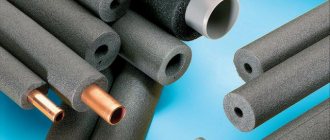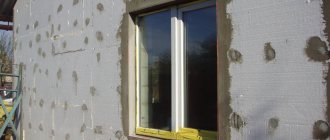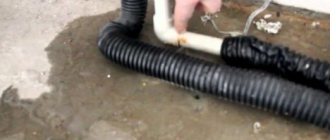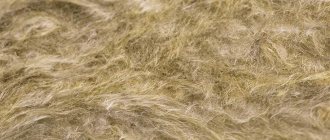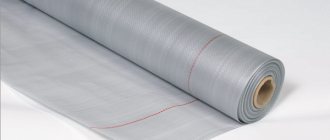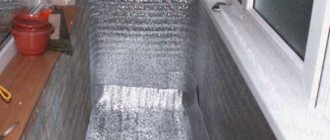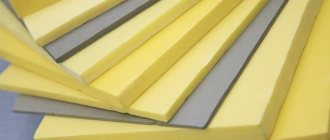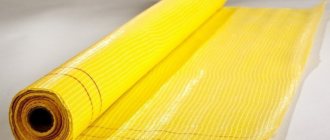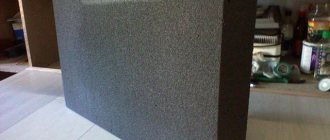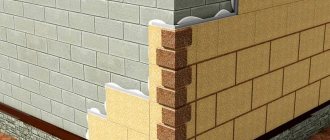Foamed polyethylene production technology
Polyethylene foam is made from high-density polyethylene (less commonly, low-density polyethylene). During the production process, fire extinguishing additives are added to the desired raw material, making the material resistant to fire. The production technology involves performing two main stages: melting polyethylene granules and combining the raw materials with liquefied gas, which is a good reagent. The gas forms the foamed structure of the future product. The production of polyethylene foam can take place using different foaming technologies:
- Non-crosslinked – extrusion + physical blowing agent (propane-butane, isobutane);
- Chemically cross-linked – mixing + azodicarbonamide, extrusion, forming and cross-linking with foaming under heat;
- Physically cross-linked – cross-linking by firing a stream of fast electrons and foaming.
Description and properties
This material is divided directly according to its structure into two main, main varieties:
- NPE or simply - unstitched;
- X(F)PPE, simply stitched.
A non-crosslinked type of material is a material produced using an extruder from solid polymer products and butane and propane gases. This variety is a linear chain of molecules without the presence of intermediate bonds, so it easily wrinkles, crumples and does not straighten after the cessation of mechanical action.
The cross-linked type of material is in turn divided into two large types:
- with physical “firmware”, denoted by the abbreviation FPPE;
- with chemical “firmware”, sometimes designated by the abbreviation KhPPE.
The main difference between this type and the first from the point of view of any chemist-technologist is that the molecules have not only a linear, but also a cross-link, that is, they are “wired” with each other.
The difference between physical and chemical cross-linking methods is that in the first case, the establishment of cross-links occurs due to the action of electrons, and in the second - chemical reagents, namely free radicals.
The cross-linked material has noticeable external differences - it has smaller bubbles, that is, cells, it is much denser and holds its shape much better.
Cross-linked and non-cross-linked types of material also differ in their properties - the cross-linked type is characterized by low thermal conductivity, it is vapor-proof, easily compressible and returns to its original shape, and also perfectly absorbs sound, for example, music, or any noise. Unstitched, accordingly, has lower performance, but also has a number of unique advantages.
The properties common to both types of material that characterize them include:
- absolute water resistance;
- resistance to the activity of any microorganisms;
- resistance to alkaline and other chemical influences;
- absence of any interaction with the environment;
- ease of installation in any area of application of the material.
A cross-linked type of material is more expensive than a non-cross-linked one, therefore, when planning to use it, it is worth considering whether polyethylene with “cross-linking” is really necessary or whether a more economical, non-stitched option will suffice.
Both types of material are covered with foil; commercially this type is called “foiled polyethylene foam.” Aluminum foil is welded to polyethylene using a thermal welding procedure, and its surface, outer layer is polished.
The use of foil not only increases the thickness of polyethylene foam, but also significantly enhances its characteristic properties:
- thermal insulation increases to 97% compared to the base;
- vapor barrier also increases significantly, due to the elimination of condensation formation;
- there is practically no effect on sound insulation, although the describing instructions allow for the effect of “reflection” of sound.
The main advantage of combining the material with foil is the increase in thermal insulation; for example, just a 10 mm layer of polyethylene foam insulation retains the same amount of heat as brick (red brick) masonry 15-20 cm thick.
Thermoflex polyethylene foam with foil is available in the following types:
- one-sided, this type of material is glued to the insulation item or wrapped around it, with a layer of foil facing out;
- double-sided, ideal for interior spaces and partitions, polyethylene foam insulation on both sides “wrapped” with foil, performs its functions equally, regardless of changes in the direction of heat flows, sound waves or noise;
- single-sided with an adhesive base, this is an “improved” single-sided type, the only difference is that you do not need to purchase glue for it;
- single-sided with film lamination, the same one-sided, but the foil layer is reinforced with a film sheet that reliably protects it from mechanical damage;
- with forced perforation is an attempt to combine the qualities of a complete insulator and a “breathable” material; reviews about it are extremely contradictory, but this type of polyethylene foam is best suited for heating and water pipes.
Also, it should be mentioned that the installation of this material is the simplest of all installation works on insulation and insulation of premises, the material weighs very little, and one pair of hands is enough to cover a room with foamed polyethylene sheets.
What equipment to choose for production
Some difficulties may arise with the selection of equipment. In our country there are almost no manufacturers of ready-made lines for the production of VP sheets. The only known one. Therefore, most likely, you will have to purchase either used. u. equipment (which suffers from frequent breakdowns), or purchase it in a new form from Chinese manufacturers. The approximate composition of the line includes: a raw material loader, an operator platform, a talc injection system, an extruder, a high-pressure pump, an anti-shrinkage unit, an extrusion head, an air ring with a blowing fan, a cooling element, a pulling device, a two-station winder, and a line control system. Estimated price of the line: from $150,000. The choice of equipment and technology for production also depends on what density of polyethylene is needed. Thus, the gas method is considered more expensive, while the chemical method is cheaper.
Features of polyethylene foam
- Low thermal conductivity. This allows it to be used for arranging thermal insulation layers of buildings and structures.
- Variety of assortment. Polyethylene foam can be “simple”, foil-clad, reinforced (for example, with fiberglass, used for greenhouses), or included in other materials. By introducing various components into the initial composition, the final product can be given the required characteristics (strength, frost resistance and a number of others).
- From an environmental point of view, the material is clean, since the use of freon is not provided for by the manufacturing technology.
- Good water-repellent properties. Foamed polyethylene is well suited for protecting surfaces that are constantly exposed to liquids.
- Ease of working with the material.
- High soundproofing qualities.
- Polyethylene foam can reduce the likelihood of ignition of other materials. For example, it is often used to protect wood.
- Some types of products can be operated in the temperature range = 240 0C (from - 60 to + 180).
- Possibility of lamination with almost any material (films, lavsan, paper and others). Thanks to this, it is used everywhere.
- Durability, elasticity, wear resistance. Not damaged by insects, rodents, mold or mildew.
- The low price of the product makes it accessible to families with any income.
comparison of thermal insulation properties
Application
For packaging goods for various purposes, as a cushioning layer
This is especially important to ensure the safety of goods transported. The material is available in thicknesses from 0.5 mm to 2 cm, which allows it to be used universally. As screens to reflect heat
This property is used, for example, when finishing saunas (steam rooms) and refrigerators. At defense enterprises. This seemingly fragile material is, for example, an “integral part” of body armor. Well, the most common use is to reduce heat loss by various structures (thermal insulation): buildings and structures, pipelines and utility wells, tanks and caissons, ventilation ducts and technological shafts.
By the way, products with one-sided foil are excellent for mounting on the wall behind heating radiators, since this increases heat transfer into the room (the efficiency of the devices increases by 1/3). But foiling on both sides is an excellent option for roof insulation. They reflect both the heat rising from inside the building and the thermal energy of the sun's rays.
Given the diverse range of products, it is impossible to list all types of products. But it is appropriate to give approximate prices for some of its varieties.
Sold in roll form. The thickness of the material ranges from 2 to 10 mm.
Price – from 23 rubles/m2.
Duplicated mats
Thickness from 1.5 to 4 cm. Suitable for thermal insulation of flat surfaces over large areas. They are connected thermally, which eliminates the need for further sealing of the seam.
Price – from 76 rub/m2.
Penofol
For arranging layers of heat and vapor barrier. In rolls, with perforation. There is a self-adhesive coating. The thickness of the material is from 3 to 10 mm, the length per roll is from 15 to 30 m with a standard width of 60 cm.
Price – from 1,200 to 1,500 rubles/roll.
Vilaterm
Thermal insulating sealing harness with a cross section of 6 mm. It is used in the temperature range from - 60 to + 80 0C. For sound and heat insulation of ventilation ducts, window and door openings (for example, in Swedish insulation technology), smoke removal systems and much more.
Price – from 3.12 rubles/l.m.
Step-by-step plan for opening a business for the production of foamed polyethylene
- Analysis of the polyethylene market.
- Renting premises.
- Purchase of equipment.
- Conducting an advertising campaign.
- Organization of sales and waste disposal.
After organizational issues are completed, it is necessary to obtain permits issued by the local administration, SES, and environmental service. Also, at the initial stage of launching production, it is worth solving the problem of waste disposal: start the production of garbage bags or enter into an agreement with a company that uses such waste in its production.
Properties of thermal insulation raw materials
Pipe thermal insulation performs a protective function for pipelines. Foamed polyethylene is used for various engineering communications:
- heating lines;
- cold and hot water supply pipelines;
- sewerage;
- air conditioning systems;
- air vents in ventilation.
For heating and hot water supply pipes, insulation is needed to reduce heat losses in the coolant and level out the thermal expansion of the material. For cold water pipes, the heat insulator serves as protection against freezing and condensation on the surface. Polyethylene foam protects sewer channels from freezing and reduces noise levels. Ventilation and air conditioning pipes are protected from ice and condensation.
Polyethylene foam performs thermal insulation functions due to its technical characteristics:
- thermal conductivity coefficient is 0.03-0.04 W/m*K;
- the density of products varies among different manufacturers from 25 to 40 kg/m3;
- water absorption – no higher than 2%;
- fire resistance class G2 in accordance with GOST 30244 (refers to moderately flammable material);
- application temperature – from -60 to +90 degrees;
- a vapor permeability of 0.001 mg/m*h*Pa allows the material to be classified as completely vapor-proof;
- minimum service life - 20 years, maximum - 80 years;
- strength is expressed in tensile strength at break up to 0.3 MPa and elastic modulus in dynamics up to 0.7 MPa;
- depending on the insulation layer, the sound absorption coefficient is from 25 to 55%;
- resistance to aggressive chemical influences.
High insulation properties demonstrate the features of insulation for pipelines for various purposes. Low thermal conductivity allows you to reduce the thickness of the heat insulator without changing the efficiency. Polyethylene foam exhibits waterproofing properties and protects metal pipes from corrosion. The material does not rot, has high hygienic indicators, fungi and bacteria do not multiply on the surface.
The disadvantages of the heat insulator are flammability at temperatures above 300 degrees, spontaneous combustion at 400 degrees. In addition, the material is not resistant to ultraviolet radiation.
Due to its elasticity, the material is resistant to deformation, but it can be damaged by sharp objects. Low cost and ease of installation allows the use of polyethylene foam at industrial facilities and in private engineering systems.
Do I need permission to open a production facility?
The production of foamed polyethylene is a harmful process. Therefore, when starting a business, you will need to obtain a certificate for the production of polyethylene and obtain permits. To successfully sell products, you will need to undergo certification for compliance with GOST 10354-82. There are also requirements for the room in which the film will be produced.
(
1 ratings, average: 1.00 out of 5)
Loading…
Similar business ideas:
- TOP 30 business ideas with minimal investment
- Production of plastic products
- TOP 30 business ideas without investment
- 6 Stages of Paper Bag Business
Properties and characteristics
First of all, you need to understand what the material is. Thus, foamed polyethylene (polyethylene foam, PE) is a material based on traditional and well-known polyethylene. However, unlike the standard variety, the foam type has a special closed-porous structure
In addition, it is important to note the fact that the foam material is classified as gas-filled thermoplastic polymers
If we talk about the time the material appeared on the market, it happened about fifty years ago. Since then, polyethylene foam has been gaining popularity among users. Today, the production of goods complies with all international standards that are prescribed in the relevant GOST.
Before you decide to purchase and use the material, you must evaluate and analyze all the available distinctive characteristics of polyethylene. It should be borne in mind that these properties are not only positive, but also negative. Nevertheless, they all constitute a set of distinctive features of the material.
So, the most important characteristics of foamed polyethylene include certain qualities.
First of all, it is necessary to say about the high flammability of the material. So, if the air temperature reaches +103 degrees Celsius, polyethylene will begin to melt (this indicator is the so-called “melting point”). Accordingly, during operation you must remember this quality of the material.
The material is resistant to low temperatures. Thus, experts report that even when the ambient temperature drops below -60 degrees Celsius, polyethylene still retains such important characteristics as strength and elasticity.
The level of thermal conductivity of polyethylene is very low and is at the level of 0.038-0.039 W/m*K. Accordingly, we can talk about a high level of thermal insulation.
During the operation of foamed polyethylene, one should take into account the fact that the material itself is capable of absorbing sound. In this regard, it is often used to equip recording studios, clubs and other premises that require mandatory sound insulation.
PE does not contain any components that can harm the human body. Accordingly, the material can be used without fear for health and life (both your own and your loved ones). In addition, even during combustion the material does not emit toxic components.
The most important characteristic of polyethylene, thanks to which it is popular and in demand among a large number of users, is the fact that the material can be very easily transported. Also important is the fact that polyethylene foam can be easily installed.
PE is a material that has a high level of wear resistance. Accordingly, we can conclude that it will serve you for a long period of time. If you try to roughly estimate the service life of the material, it is approximately 80-100 years.
During the operation of the material, it is imperative to take into account the fact that it is destroyed by exposure to ultraviolet radiation. Accordingly, direct use of the material must be carried out under protected conditions.
Great variety in terms of color, shape and type of design. The most popular and in demand are rectangular sheets in black and white.
The thickness of polyethylene may vary. This indicator plays a decisive role when choosing a material. So, depending on your needs and preferences, you can choose PE with a thickness of 10 mm, 50 mm, 1 mm or 20 mm.
In addition to the functional characteristics of PE, it is important to study in detail the chemical and physical qualities of PE (for example, properties such as density, ability to absorb moisture, etc. play an important role)
Among the distinctive chemical and physical properties of the material are:
- the recommended temperature range for use of the material is from -80 degrees Celsius to +100 degrees Celsius (at other temperatures the material loses its characteristics and qualities);
- strength can range from 0.015 MPa to 0.5 MPa;
- the density of the material is 25-200 kg/m3;
- Thermal conductivity index is 0.037 W/m per degree Celsius.
Application
Although installation work with this material is characterized by increased simplicity, ease and does not require any special skills at all, there are still a number of requirements for this process:
- before you begin installation, simply gluing the insulating polyethylene material to the surface, it should be thoroughly cleaned, all damage, if any, should be repaired and thoroughly primed, in at least two layers;
- the material is laid on a wall well coated with glue, or by leaning the “built-in” adhesive layer against the surface, while additionally securing it with staples or “fungi” dowels;
- On top of the insulation layer, if necessary or desired, you can mount a frame on which to later attach either a base for a “living” wall or ready-made finishing panels. Or anything else;
- the foil layer is always laid this way - for external gluing - outward, that is, “outside”, to reflect the cold, and for internal installation - inward, to prevent the outflow of heat;
- The joints of the material must be well glued, avoiding the appearance of gaps or cracks; for maximum reliability, they should be additionally glued with metallized construction tape for insulation.
When wrapping pipes yourself in a “fur coat” of polyethylene insulating layer, there is also nothing complicated. On finished heat-insulating cylinders there is a line of punched holes, which is often mistaken for perforation.
We recommend: Boiler Proterm Gepard: characteristics, instructions, settings, errors
However, the perforations on the material are applied in the form of “punctures”, and the dividing line is in the form of a dotted line. Along this dotted line, the “body” of the cylinder is cut, after which it is put on the pipe, and the joint is glued.
A prerequisite is that the pipe is clean and dry when installing the insulator; it is not forbidden to coat the insulated pipe with glue. For metal pipes, you will need to pre-treat them with anti-corrosion compounds and anti-rust agents.
Foamed polyethylene installation technology
Any insulating material requires certain installation specifications.
Foamed polyethylene also has its own characteristics. After cleaning the surface, PPE is glued and secured. The maximum effect is achieved if there is air space between the material and the cladding. To create a layer, a paving sheathing is installed between the isomer and the finishing coating. The frame protects surfaces from moisture accumulation. Condensation formed during sudden temperature fluctuations evaporates. At the same time, the external finish remains intact. To insulate any surfaces, no scrupulous preparation is required. You just need to smooth out the bumps and depressions, clean them from dust, dirt and dry them.
Reflective insulation
To enhance the vapor and heat insulation properties of PPE and NPE, the material is used with foil as a reflective element using heat sealing, and in some cases, polyethylene film is applied, further protecting the polymers from damage.
As a result:
- surfaces are reliably protected from moisture penetration (100%);
- Polymers reinforced with foil greatly improve their thermal insulation properties - they are equivalent to thick brickwork. 15 cm.
Modifications to foil protected material
- External covering. Layered on the thermal insulation material on one side.
- Double-sided coating. It is used for insulation of floors and internal walls.
- Combined coating. One side is treated with glue. The consumer can save money on additional purchase of glue.
- Double coating. A protective film is applied over the foil to protect the material from damage.
- Protection of foil with perforated material. Along with thermal insulation, in some cases it is necessary to make the surface breathable and permeable to steam.
Thermal insulation performs a variety of functions, and it can be useful anywhere. Aluminum foil reflects up to 98% of heat and prevents heat loss. The material is suitable for insulation:
- attic;
- attic spaces;
- niches behind central heating radiators in apartment buildings and cottages.
In addition to the objects mentioned, aluminum-coated material provides excellent protection for industrial equipment. It is characterized by:
- high elasticity;
- excellent sound and heat insulation;
- durability;
- convenient mounting.
The material is safe, easy to cut and install.
Installation of walls using foil polyethylene foam
The polymer is easy to cut. It is placed on a flat surface, using nails, tape, and a stapler for fastening, and layered with a reflective part in the direction of the heat source.
Package
Polyethylene foam for packaging is usually made from non-crosslinked polyethylene polyethylene and is supplied in the form of rolls, finished products or bags of various sizes.
Packaging products made from PPE absorb shock, reduce vibration, and protect against mechanical damage during transportation. To increase strength and enhance heat-shielding properties, packaging materials are covered with foil, kraft paper, nylon or polyethylene film.
PPE packaging is widely used for transporting household appliances, electrical appliances, dishes, furniture, and shoes.
Figure 14. Non-crosslinked PPE packaging.
Pipe shells
Shells for pipes of various diameters. For convenience, the insulation of installed pipes is produced with cuts along the shells, or without cuts. Uncut shells are provided with perforations along the intended cuts.
Figure 10. Polyethylene foam shells.
They are produced with an outer diameter from 6 to 114 millimeters, shell thickness from 6 to 25 millimeters.
Shells insulate heating, cold and hot water supply, ventilation and air conditioning pipelines.
Compensation mats
They are made by gluing sheets of polyethylene foam under the influence of high temperatures. Supplied in the form of sheets measuring 1000x2000 millimeters, with a thickness of ten to one hundred millimeters.
Figure 11. PPE mats.
Harnesses
They are cylindrical seals with diameters from 6 to 120 millimeters. Thin strands with a diameter of up to 12 millimeters are intended for installing expansion joints in concrete floors; strands from 12 to 20 millimeters are used to seal gaps between door and window frames. Thicker strands are used to fill the joints between panels of precast concrete houses.
Figure 12. Polyethylene foam bundles.
Substrate
It is made from cross-linked polyethylene foam and is used as an intermediate gasket between concrete screeds and laminate flooring.
Supplied in rolls up to three meters wide, with a web thickness of two to five millimeters.
Figure 13. PPE floor underlay.
